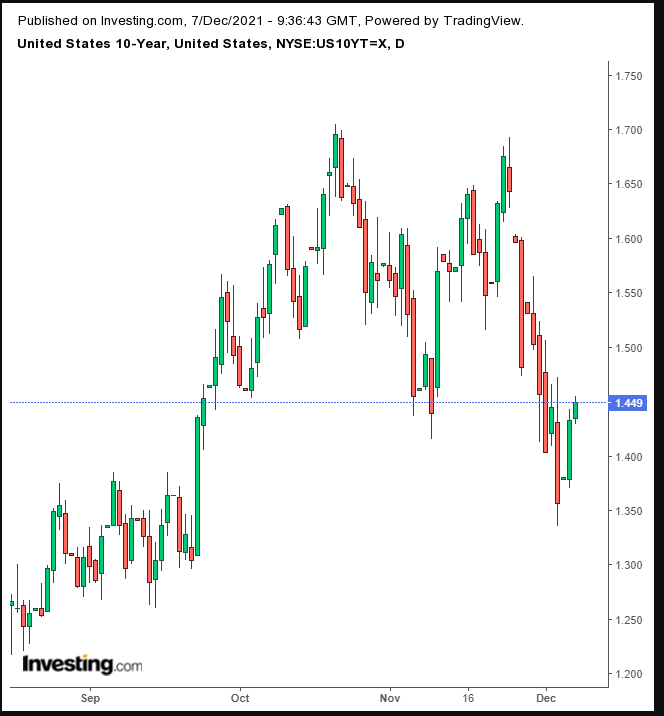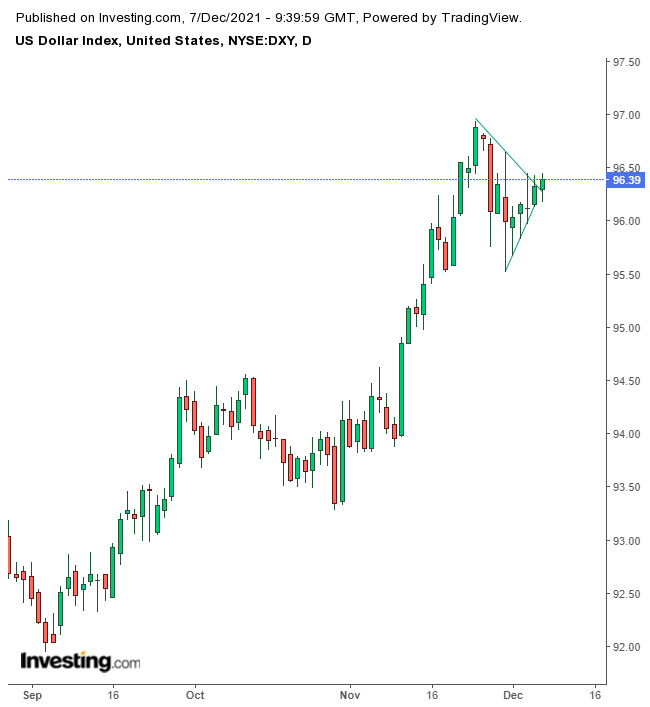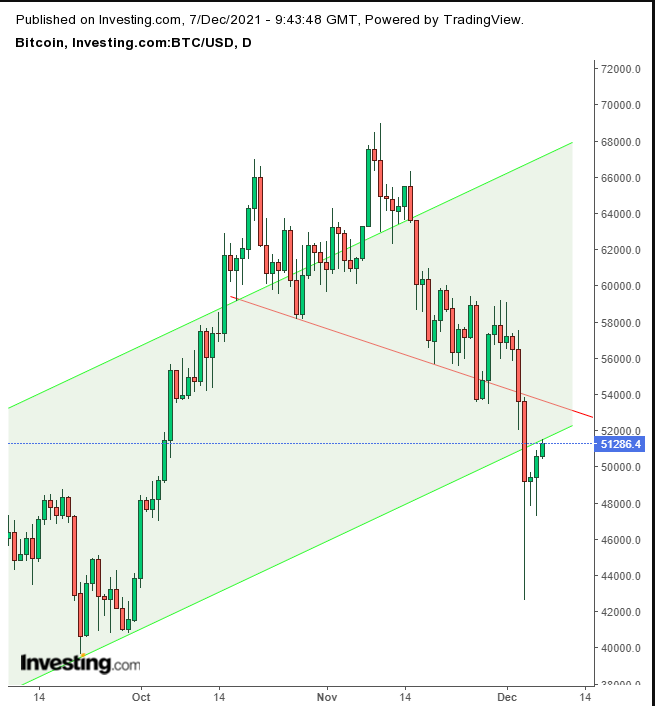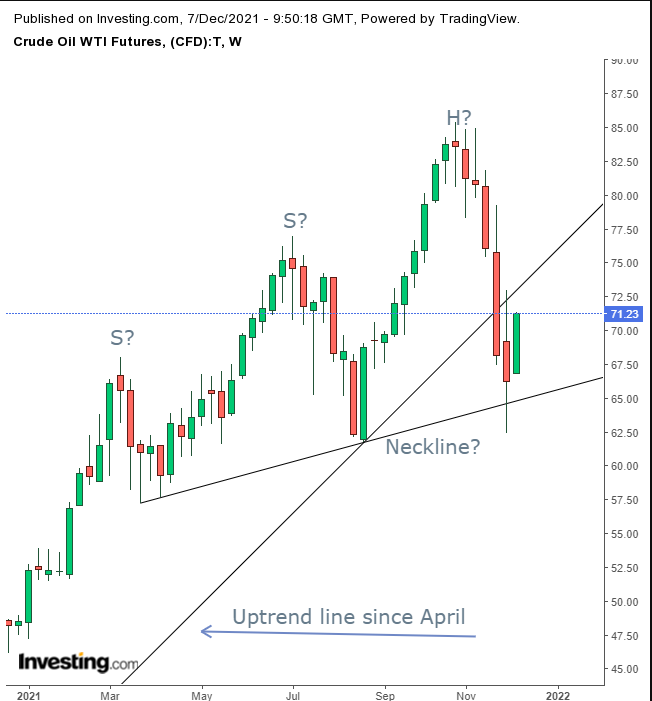- While the focus is on rising tech stocks, small caps also recovered
- Oil rally continues
- Bitcoin moves higher
Key Events
US contracts on the Dow Jones, S&P 500, NASDAQ and Russell 2000 as well as global stocks advanced in trading on Tuesday as investors continue to take advantage of the Omicron dip. Traders now think the dramatic selloff in reaction to the discovery of the new strain of COVID-19 last week was overdone. The news from China, that it will ease requirements for bank reserves, has also buoyed investor sentiment.
The dollar advanced while gold was flat.
Global Financial Affairs
All four US futures were well into positive territory, with the Russell 2000 and NASDAQ 100 neck and neck for the lead. It is always interesting when these two futures contracts lead in tandem as they represent opposite sides of the reflation trade. The NASDAQ 100 includes 102 non-financial stocks, most of which are technology-centered companies which traders expect to outperform when the economy is under pressure. Conversely, the stocks listed on the Russell 2000 index tend to be small-cap, domestically focused companies which are more sensitive to any social restrictions introduced due to COVID-19.
Another notable mention is that the Dow Jones contracts are the worst-performing. While firms listed on the oldest of Wall Street's averages include some large cap, multinationals, the benchmark overall represents value stocks.
Companies listed on the Russell and the Dow are on opposite ends of the size spectrum but they have performed in a similar way on coronavirus news. However that link seems to be broken as investors consider the recent plunge in the Russell 2000 which rendered the benchmark oversold thereby offering more relative value than the Dow Jones.
In Europe on Tuesday, shares opened higher following Wall Street's higher close on Monday. The STOXX 600 Index ascended along with the technology sector.
Earlier in Asia—the bridge between American and European trading—markets rebounded from yearly lows, boosted by the news that The People's Bank of China reduced bank reserve requirements, thus increasing liquidity to lubricate the flagging economy amid a property market slump.
Still, the world's second-largest economy expanded more rapidly than expected in November on record export demand.
In the US, stocks bounced back yesterday from last Friday's selloff on reports that Omicron's symptoms are milder than feared.
The S&P 500 advanced 1.2% on Monday, wiping out last week's decline while the NASDAQ 100 added 0.9% of value as investors turned risk-on after positive reports from South Africa on the new variant which calmed concerns that hospitals would be overrun.
Treasury yields on the 10-year note rebounded for the third straight day but remain stuck below 1.5%. We think the current spike is likely to be short-lived based on the technicals.

Rates are struggling to climb back above the neckline of an H&S bottom.
The dollar advanced for the fourth of five days, as it aims to complete a bullish pattern.

The greenback may be edging above a pennant, an interruption within the underlying uptrend.
Gold was little changed.
Bitcoin rose for the third day in a row but it is likely to be a corrective move within a downtrend.

The cryptocurrency is stuck below the rising channel it fell out of after completing a downsloping H&S top, one formed with a weak bullish component that failed to develop a right shoulder even with that of the left.
Oil rebounded for the second day as concerns abated that the new COVID-19 variant would dent global demand. We, however, are not convinced by this rally.

While the price found support by a relatively flat uptrend line since March, it will have to prove it can climb back above the violated uptrend line since April. Moreover, the uptrend line has been supporting it since last week and it may prove to be the neckline of an upsloping H&S top. Such a top could mean that bulls are giving all they got as they believe weak demand conditions will turn around. An upsloping H&S pattern brings to mind the maxim:
"The higher they are, the harder they fall."
Up Ahead
- The Reserve Bank of India announces its rate decision on Wednesday.
- On Wednesday, the President of the European Central Bank, Christine Lagarde speaks at a conference.
- On Thursday China publishes CPI figures.
Market Moves
Stocks
- The STOXX 600 rose 1.5% as of 8:44 a.m. London time
- Futures on the S&P 500 rose 1%
- Futures on the NASDAQ 100 rose 1.4%
- Futures on the Dow Jones Industrial Average rose 0.8%
- The MSCI Asia Pacific Index fell 0.9%
- The MSCI Emerging Markets Index fell 0.9%
Currencies
- The Bloomberg Dollar Spot Index fell 0.1%
- The euro was little changed at $1.1289
- The Japanese yen fell 0.1% to 113.65 per dollar
- The offshore yuan was little changed at 6.3689 per dollar
- The British pound was little changed at $1.3274
Bonds
- The yield on 10-year Treasuries was little changed at 1.44%
- Germany's 10-year yield advanced two basis points to -0.37%
- Britain's 10-year yield rose two basis points to 0.76%
Commodities
- Brent crude rose 1.7% to $74.33 a barrel
- Spot gold rose 0.3% to $1,783.42 an ounce
